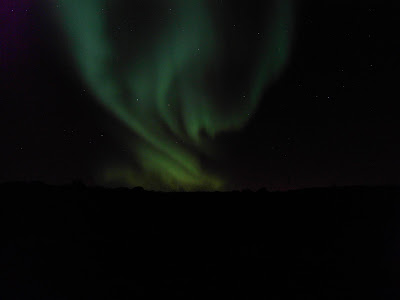The weather here was been absolutely beautiful, other than some overcast skies over the weekend. Despite the -20 temperatures, the weather continues to be unseasonably mild! It should be between -30 and -40 pretty consistently from mid-January to mid-February. I personally am prepared to accept that this is a result of the effects of La Nina, with a touch of global climate change, and keep things as they are! Clear and sunny skies during the day make for fantastic aurora borealis (northern lights) viewing when the sun goes down, which is shortly after 3pm these days. That means I get to enjoy the show on my walk home from work at 5pm. I haven’t done much this week other than catch up at work, so I thought we could talk a little bit about auroras.
You can often find me standing on the side of the road as cars dash by with my eyes on the sky (I discovered some time ago that it is not wise to look up while attempting to walk). At these moments I feel very child-like, marvelling over some natural phenomenon for the first time. I am usually too mesmerized and awe-inspired to think too much about what they are and why they occur – they are almost too beautiful to be explained - but alas the scientist in me eventually takes over and I like nothing more than a good science lesson…
So what are they? The bright dancing lights of the aurora are actually the result of collisions between gaseous particles in the Earth's atmosphere with charged particles released from the sun's atmosphere. I said what? You may have to read this sentence a couple of times to really take in what it says.
The Earth is constantly immersed in the solar wind, a continuous flow of free electrons and positive ions emitted by the Sun - a result of the million-degree heat of the Sun's outermost layer, the corona. Blown towards the earth by the solar wind, these charged particles are largely deflected by the earth's magnetic field; however, the earth's magnetic field is weaker at the poles so that some particles enter the earth's atmosphere and collide with gas particles. Collisions between these ions and atmospheric atoms and molecules cause energy releases in the form of the dancing lights of the auroras. Seen from space, these fiery curtains form a thin ring around the earth’s pole (see pictures below... so awesome).
Variations in the colour of auroras are due to the type of gas particles involved in the collisions. The most common aurora color, a pale yellowish-green (you have seen these in some of my pictures, by far the most common I have seen), is produced by oxygen molecules about 100km above the earth’s surface. Rare, all-red auroras are produced by high-altitude oxygen at heights up to 500km, whereas nitrogen produces blue or purplish-red aurora. The lights of the aurora extend from about 80km above the earth to as high as 640km and typically appear as a diffuse glow or as “curtains” that extend in an east-west direction. Each curtain consists of many parallel rays lined up with the direction of the magnetic field lines. At some times they form "quiet arcs", while at others they are "active auroras" and evolve and change constantly.
Auroras are seen in both the northern and southern hemispheres. 'Aurora borealis', the lights of the northern hemisphere, means 'dawn of the north'; 'Aurora australis' means 'dawn of the south'. Interestingly, scientists (oh, those scientists!) have learned that in most instances northern and southern auroras are mirror-like images of each other that occur together with similar shapes and colors, though in the south the lights are not often seen as they are concentrated in a ring around Antarctica and the southern Indian Ocean.
In Roman myths, Aurora was the goddess of the dawn. Many cultural groups have legends about the lights. In medieval times, the occurrences of aurora displays were seen as harbingers of war or famine. The Maori of New Zealand shared a belief with many northern people of Europe and North America that the lights were reflections from torches or campfires. The Menominee Indians of Wisconsin believed that the lights indicated the location of manabai'wok (giants) who were the spirits of great hunters and fishermen. The Inuit of Alaska believed that the lights were the spirits of the animals they hunted: the seals, salmon, deer and beluga whales. Other aboriginal peoples believed that the lights were the spirits of their people.
The best time of year to watch for aurora displays is in the spring and fall (I didn’t see any until well into September), but winter in the north is also generally a good season because of the long periods of darkness and the frequency of clear nights. Researchers have also discovered that aurora activity is cyclic, peaking roughly every 11 years, with the next peak period in 2013. Not sure that I will still be here then...
They are occasionally seen in temperate latitudes, when a magnetic storm temporarily expands the aurora oval. Large magnetic storms are most common during the peak of the eleven-year sunspot cycle or during the three years after that peak. The auroras that resulted from the "great geomagnetic storm" on both August 28 and September 2, 1859 are thought the most spectacular in recent recorded history. The aurora event which occurred on September 2, 1859 produced aurora so widespread and extraordinarily brilliant that they were seen and reported in published scientific measurements, ships' logs and newspapers throughout the United States, Europe, Japan and Australia.
Check out these amazing pictures! I didn’t take these pictures, by the way... in case there was any confusion...
Aurora borealis

 Aurora australis
Aurora australis


No comments:
Post a Comment